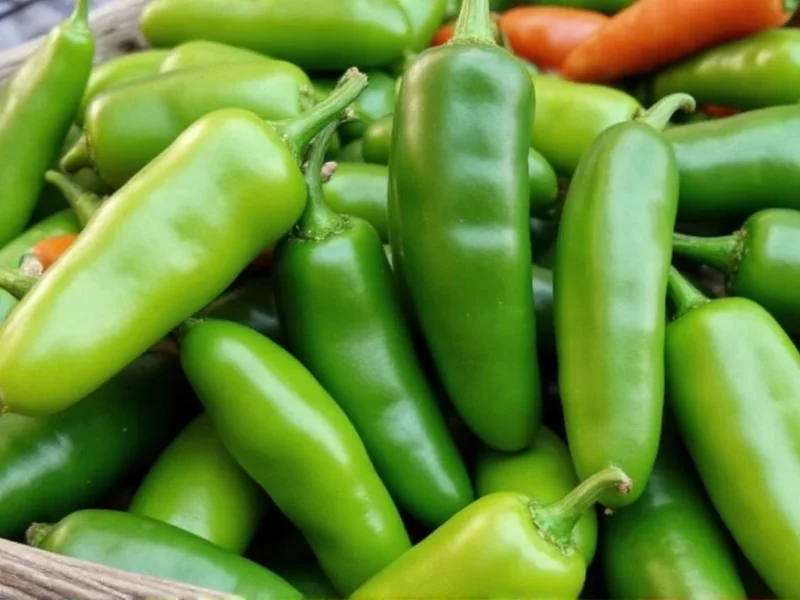Understanding the precise heat measurement of jalapeños helps home cooks and culinary professionals determine appropriate usage in recipes. The Scoville scale, developed by pharmacist Wilbur Scoville in 1912, measures the concentration of capsaicinoids—the compounds responsible for a pepper's heat—in Scoville Heat Units.
Understanding Jalapeño Heat Range
While the standard range for jalapeños is 2,500-8,000 SHU, several factors influence where an individual pepper falls within this spectrum. The heat isn't evenly distributed throughout the pepper either—seeds and white pith contain the highest concentration of capsaicin, the primary heat-producing compound.
For accurate measurement context, consider that bell peppers register at 0 SHU, while the Carolina Reaper, one of the world's hottest peppers, can exceed 2,000,000 SHU. This comparison helps visualize where jalapeños sit in the broader chili pepper landscape.
Factors Affecting Jalapeño Heat Levels
Several variables impact how many scoville units is a jalapeño actually delivers:
- Stress conditions: Peppers grown in less-than-ideal conditions often develop higher heat levels as a defense mechanism
- Ripeness: Red jalapeños (fully ripe) tend to be slightly hotter than green ones
- Genetic variation: Different jalapeño cultivars have distinct heat profiles
- Geographic origin: Soil composition and climate affect capsaicin production
- Storage conditions: Heat can intensify slightly as peppers age
| Pepper Type | Scoville Heat Units (SHU) | Heat Level Comparison |
|---|---|---|
| Jalapeño | 2,500-8,000 | Mild to Medium |
| Serrano | 10,000-23,000 | Medium-Hot |
| Habanero | 100,000-350,000 | Very Hot |
| Bell Pepper | 0 | No Heat |
Practical Implications for Cooking
Knowing how many scoville units is a jalapeño provides valuable insight for recipe development. When substituting jalapeños in recipes, consider these practical applications:
For milder results, remove seeds and white membranes before use. If you're wondering how hot are jalapeño peppers compared to other common chilies, they're approximately 2-5 times hotter than poblanos but significantly milder than habaneros. This makes them ideal for introducing moderate heat to dishes without overwhelming other flavors.
Chefs often roast jalapeños to mellow their heat while enhancing their natural sweetness—a technique particularly useful when working with hotter specimens at the upper end of the scoville units for jalapeño range.
Historical Context and Modern Usage
Jalapeños originated in Mexico and have been cultivated for thousands of years. The name comes from Xalapa, the capital city of Veracruz state, where they were traditionally grown. Today, jalapeños rank among the most popular chili peppers worldwide, featuring prominently in Mexican cuisine and increasingly in fusion dishes globally.
Modern agricultural practices have led to more consistent jalapeño heat levels, though natural variation remains inevitable. Some specialty growers now cultivate specific jalapeño varieties targeting particular points on the scoville heat scale for culinary applications.
Measuring Pepper Heat Accurately
While the Scoville Organoleptic Test was the original method for determining how many scoville units is a jalapeño, modern laboratories use High-Performance Liquid Chromatography (HPLC) for precise measurement. This scientific approach quantifies capsaicinoid concentration directly, then converts to Scoville units using a standardized formula.
Home cooks shouldn't rely on visual cues alone to determine jalapeño heat level. Even within the same pod, heat can vary significantly from stem to tip. The only reliable method is tasting a small piece—starting with the tip, which is usually mildest.
Frequently Asked Questions
Why do some jalapeños taste much hotter than others?
Jalapeño heat varies due to growing conditions, ripeness, and genetics. Stress factors like inconsistent watering or nutrient deficiencies can increase capsaicin production. The seeds and white pith contain the highest concentration of heat compounds, so peppers with more developed seeds often taste hotter.
How can I reduce the heat of jalapeños in cooking?
To reduce jalapeño heat, remove all seeds and white membranes before use. Soaking sliced peppers in salt water or milk for 15-30 minutes can also draw out some capsaicin. Cooking methods like roasting or boiling can mellow the heat while preserving flavor.
Are red jalapeños hotter than green ones?
Generally, red jalapeños (fully ripe) are slightly hotter than green ones, though the difference is often minimal. The ripening process can increase capsaicin concentration, but red jalapeños also develop more sugars, which can balance the perceived heat. The specific growing conditions have a greater impact on heat level than color alone.
What pepper has a similar heat level to jalapeños?
The Fresno pepper most closely matches jalapeño heat (2,500-10,000 SHU), making it the best substitute. Other comparable options include the serrano (though typically hotter at 10,000-23,000 SHU) and certain varieties of poblano peppers (1,000-2,000 SHU, generally milder). When substituting, start with less than the recipe specifies and adjust to taste.
Can I grow jalapeños with consistent heat levels?
Achieving consistent jalapeño heat requires controlled growing conditions. Maintain regular watering, provide balanced fertilizer, and grow in stable temperatures (70-85°F). Some cultivars like 'TAM Jalapeño' have been bred for more uniform heat. Even with optimal conditions, some natural variation is inevitable due to the complex biology of capsaicin production.











 浙公网安备
33010002000092号
浙公网安备
33010002000092号 浙B2-20120091-4
浙B2-20120091-4